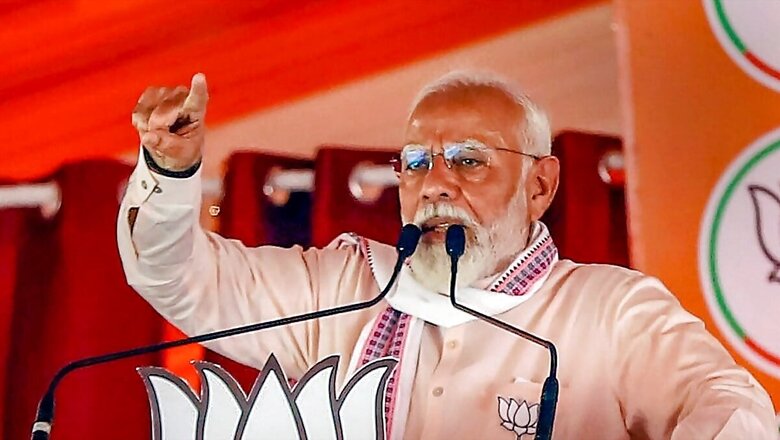
views
Pakistan, nepotism, and institutionalised corruption dominated his 52-minute-long speech. “It used to be ‘bhai-bhatija’ (brother-nephew) then it became ‘mama-bhanja’ (uncle-nephew) and now it is the ‘saas, bahu aur damad’ (mother-in-law, daughter-in-law, son-in-law) episodes running on the TV serial titled corruption in India,” said Modi, in a no-holds-barred attack on the Congress, something India was getting used to in the run-up to the general elections due next year.
Ever since then up until the 2014 Lok Sabha elections, India saw a political discourse that was aggressive, shunning any niceties, and unapologetic about taking names. Narendra Modi became its main protagonist. The monologue was turned interesting when Modi asked questions to the crowd and they responded. He asked all BJP spokespersons at a closed-door media workshop to do their homework and appear aggressive.
India was getting used to Modi’s way and has ever since been comfortable with it. But over the years, a fierce leader ready to create a new order gave way to a keen statesman who had to launch new schemes and take them to saturation level in a time-bound manner while making India’s international standing enviable. While he continued to give high-decibel election speeches in rallies, many often felt the “fizz” was missing that only a disruptor could bring with him.
Hence, “saas, bahu aur damad” gave way to a softer “parivarvaad”. In April 2014, then BJP prime ministerial candidate Narendra Modi called Robert Vadra a “baazigar” (conjurer) in a Gurugram rally. “Is there any youth in Gurgaon who can say that he does not have any money now but in three months he can accumulate Rs 50 crore? Is there any baazigar like that? Shehzada, the country wants to know ‘Who is this baazigar who has acquired farmers’ land forcibly and earned Rs 50 crore in three months?’ ‘What is your relationship with this baazigar?'” Modi said at the rally.
Over time, “baazigar” morphed into a more acceptable “damaad”. Even “Shehzada” became “Congress ke ek neta” in 2020 though he continued to take intermittent digs at Rahul Gandhi through different names like “tubelight”.
At a rally in October 2012, Modi called Dr Mamohan Singh, who was known for staying silent on crucial issues, “Maun (mum)” Mohan Singh. Referring to a speech the then PM made in Una, Modi said: “Aaaj ki sabse badi khabar hai ki Maun Mohan Singh ne apna maun tod diya (Today’s biggest news is that ‘Maun-Mohan’ Singh broke his silence).” In 2013, at a BJP national council meeting in Delhi, Modi called Dr Singh a “night watchman”. But notwithstanding Modi’s recent jibe over a 2009 comment of Singh, the PM has ever since stayed away from using such adjectives against the senior congress leader. This February, Modi called Singh a “shining example” of what an MP should be.
But as India thought the Modi of 2013-14 was history, he made a comeback a decade later. “Shehzada” is back again in his vocabulary. Criticising the Congress on the “inheritance tax” issue, Modi remarked, “Shehzada’s X-ray machine will scan for mangalsutras.” Almost as a precursor, this February while criticising Rahul Gandhi’s “nashedi” remarks that created a row, Modi called him “Yuvraj”.
The Modi of 2013 was someone who would use popular terms and taglines out of his pocket, a trend that stopped long ago. While ending the BJP’s attack on the Congress over inheritance tax, Modi used the tagline of Life Insurance Corporation (LIC) that says “Zindagi ke saath bhi, zindagi ke baad bhi”.
“Today, driven by the greed for power once again, these people want to reintroduce the same law. After accumulating limitless wealth for generations without taxes on their families, now they want to impose taxes on your inheritance. That’s why the country is saying ‘Congress ki loot, zindagi ke saath bhi, zindagi ke baad bhi’,” Modi remarked in a rally in Uttar Pradesh’s Aonla.
Modi’s active outreach to Pasmanda Muslims back home or visiting Al-Hakim Mosque in Egypt’s Cairo made many of his core constituents confident that he wouldn’t make any remarks that can play to this gallery. But dismantling that notion, Prime Minister Narendra Modi on Sunday in a rally in Rajasthan’s Banswara spoke about “infiltrators” who would take India’s wealth if the Congress gained power. Referring to a 2006 statement of Dr Manmohan Singh, a short video of which was circulated on social media by the BJP, Modi remarked that the then PM “said that Muslims have the first right to the wealth of the nation. This means they will distribute this wealth to those who have more children, to infiltrators”.
He didn’t stop there. On Tuesday, in another rally in Rajasthan — this time in the Tonk-Sawai Madhopur Lok Sabha constituency — the Prime Minister was back in his element attacking the Congress. He claimed that the Congress has often tried to give reservations to a “particular community” by reducing the quota for Scheduled Castes, Scheduled Tribes, and Other Backward Classes, and that it “did not care” about the Constitution. PM Modi used the term “khaas jamaat” to loud claps.
It’s a seven-phase election and he is just getting started.
Explore Live updates on the Lok Sabha Elections 2024 News . Check Lok Sabha Election 2024 Phase 3 Schedule, Key Candidates And Constituencies At News18 Website.


















Comments
0 comment